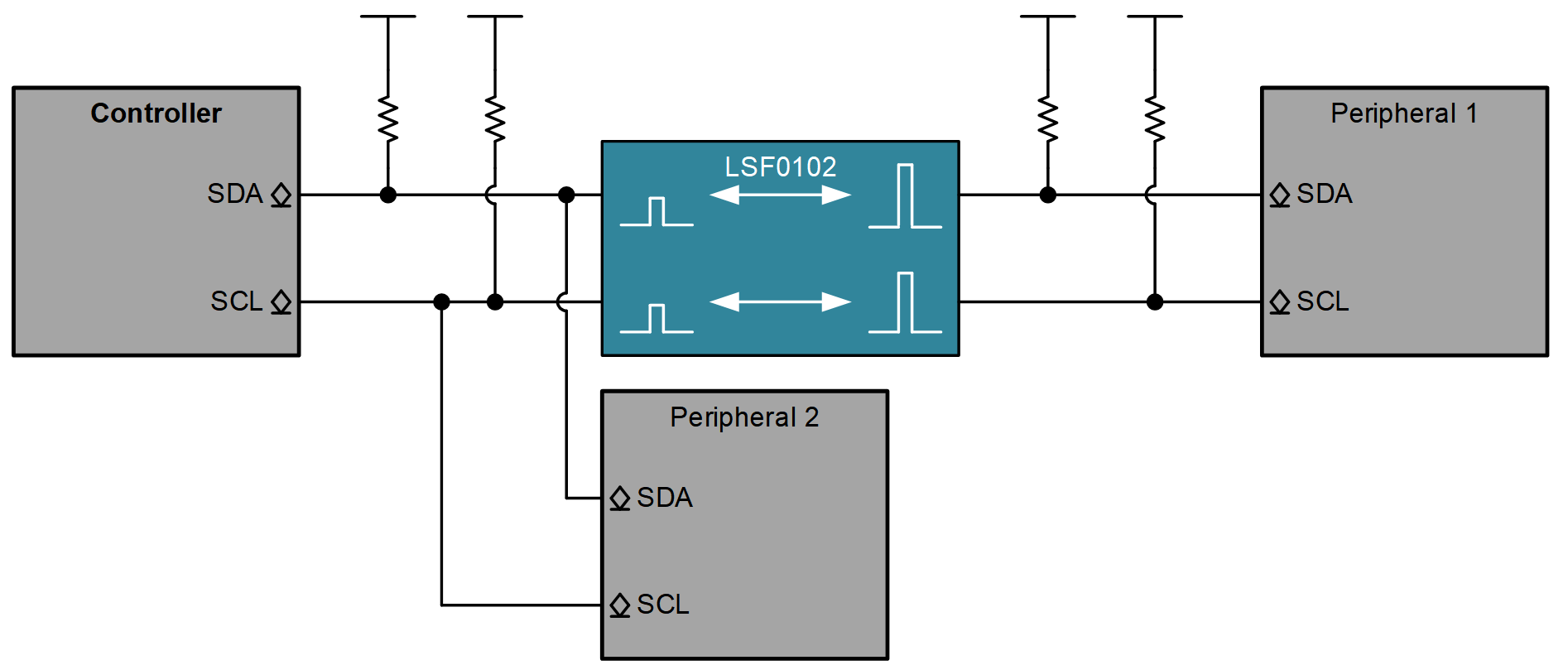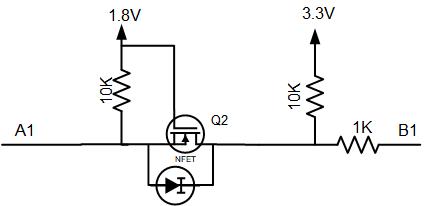SDLA007 January 2024 LSF0101 , LSF0102 , LSF0102-Q1 , LSF0108 , PCA9306 , PCA9306-Q1 , TXS0101 , TXS0102 , TXS0102-Q1 , TXS0104E , TXS0108E , TXS0108E-Q1
1
Most engineers are familiar with the classic open drain level shifting implementation that uses simple MOSFETs (Metal Oxide Semiconductor Field Effect Transistors) and a combination of a few discrete components (see Example Singel Bit Discrete Open-Drain Level Translation Implementation). Given the implementation simplicity and low cost, variations of the MOSFET based open drain level shifter circuits have been used by engineers for a very long time and this approach remains a frequently used tool in a design engineer’s tool box.
Using a discrete open drain level shifter implementation does require designers to accept compromises such as reduced data rates, higher levels of power consumption, and large implementation size. Historically, these compromises might not have had a critical impact on the target application enabling designers to accept the compromises of the traditional discrete approach. However, today design engineers are challenged with designing systems that are not only lower cost but also lower power, higher performance, and much smaller in terms of form factor.
The modern system design challenges that system designers face can make using traditional discrete open drain level shifting difficult if not impossible in many cases. See Table 1. For example, a battery operated video doorbell is not likely to have the needed board area and power budget to implement a traditional discrete open drain level shifter design. Similarly, a hand-held Mobile Point of Sale (POS) terminal, that needs to maximize battery life while still maintaining a small form factor, cannot afford the compromises a discrete design can require.
How can system designers enjoy many of the benefits of discrete open drain level translation while meeting the modern system design challenges of smaller system form factors, power efficiency, and higher performance? The simple answer is to use power efficient integrated level shifter circuits that are now available in small uQFN packaging technologies. The latest integrated open drain level shifters enable designers to implement 0.95-V to 5.5-V open drain level shifting with the flexibility of external resistor components, that engineers are accustomed to, but without the large MOSFET footprint.
Integrated open drain level shifters can replace MOSFET based open drain level shifting implementations as shown in Figure 1. The benefit of using new integrated level shifters is that the devices are now widely available in small uQFN packages that are considerably smaller than SOT packaging of low-cost MOSFETs enabling much smaller circuit implementations. uQFN packages are more than three times smaller than the SOT-23 package commonly used for MOSFETs. In addition, an integrated level shifter device consumes much lower power and supports higher data rates than discrete based implementations. Unlike MOSFETs, integrated open drain level shifters are designed not to suffer from high leakage that is common with traditional MOSFET designs. Given the always on nature of MOSFET based implementations, discrete implementations can greatly reduce the battery life of the application they are used in.
Integrated level shifter devices also have additional benefits not found with MOSFET based implementations such as built-in ESD protection and deterministic data sheet specifications such as switching characteristics that enable more robust higher performance designs. For example, LSF0101DTQR (single channel), PCA9306DQER (dual channel) and LSF0102DQER (dual channel) open drain level shifters from TI enable system designers to achieve smaller, power efficient and higher performance designs while still maintaining the flexibility of external resistors of the discrete approach that designers might want.
TI's TXS family of open drain level translators offers the added benefit of integrated pull-up resistors further reducing component count. Devices like TXS0102DQER can be used for level shifting interfaces such as I2C in space constrained use cases. The cost benefit of discrete designs is greatly diminished when cost of additional components and ESD protection is considered. The benefits of using integrated open drain level shifters, for example, are multiplied when you consider that most systems have multiple bits or interfaces that need open drain level shifting. Using discrete devices to implement multiple level shifting channels dramatically increases the number of components that need to be sourced and implemented for a design.
Level shifter devices such as LSF0101DTQR, PCA9306DQER, and LSF0102DQER enable designers to implement more robust and efficient open drain translation in the next generation of system designs while helping designers achieve modern system design goals. For more information on the LSF series, PCA/TCA series, and TXS series of level translation designs, please visit TI’s level translation landing page.
| Integrated Level Translation | Discrete Level Translation | |
|---|---|---|
| Implementation Complexity | Low | High |
| Component Count | Low | High |
| Power Dissipation/Bit | Low | High |
| Known Rise/Fall Times | Yes | No |
| Higher Data Rate Support | Yes | Limited |
| Signal Glitching | No | Likely |
| External ESD Needed | No | Yes |
| Power Sequencing Needed | No | Yes |
 Figure 1 Integrated Level Translation using LSF0102 Level Translator
Figure 1 Integrated Level Translation using LSF0102 Level Translator Figure 2 Example Singel Bit Discrete Open-Drain Level Translation Implementation
Figure 2 Example Singel Bit Discrete Open-Drain Level Translation Implementation